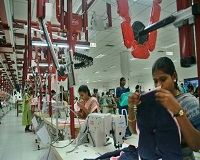The government, in order to support the industry, has increased import duty on several textile items. However, to ensure long-term sustainable revival, it first needs to address certain deep-rooted problems. Currently, the industry is finding it extremely difficult to compete with even smaller players such as Bangladesh and Vietnam. Valued at around $127 billion, the textiles and apparels industry is a huge foreign exchange earner, and second-largest employer in India. However, the country’s share in global textiles exports is just 5 per cent, which is minuscule as compared to China’s share of 38 per cent. Much smaller players like Bangladesh and Vietnam, having a share of 3 per cent in global exports, are increasingly threatening India’s exports.
 The government, in order to support the industry, has increased import duty on several textile items. However, to ensure long-term sustainable revival, it first needs to address certain deep-rooted problems. Currently, the industry is finding it extremely difficult to compete with even smaller players such as Bangladesh and Vietnam.
The government, in order to support the industry, has increased import duty on several textile items. However, to ensure long-term sustainable revival, it first needs to address certain deep-rooted problems. Currently, the industry is finding it extremely difficult to compete with even smaller players such as Bangladesh and Vietnam.
Competition, domestic issues trample growth
Valued at around $127 billion, the textiles and apparels industry is a huge foreign exchange earner, and second-largest employer in India. However, the country’s share in global textiles exports is just 5 per cent, which is minuscule as compared to China’s share of 38 per cent. Much smaller players like Bangladesh and Vietnam, having a share of 3 per cent in global exports, are increasingly threatening India’s exports.
Other bug bears are domestic issues. Textile exports were expected to increase with the abolition of the Multi Fibre Arrangement (MFA) in 2005-06. However, this growth did not materialise, as the industry faced increased competition from low-cost producers like Vietnam and Bangladesh. The rise in Chinese labour cost could also have provided an opportunity to increase its share in the global textiles industry. But domestic issues including outdated technology, inflexible labour laws, infrastructure bottlenecks, and a fragmented nature of the industry trampled these hopes.
As per World Trade Organisation’s Agreement on Subsidies and Countervailing Measures, a country needs to phase out export subsidies for a product as it achieves export competitiveness, defined as 3.25 per cent share in world trade. As per this agreement, India needs to end export subsidy for the textiles sector by 2018. The industry needs to abolish some of the existing export subsidies such as Merchandise Export from India Scheme (MEIS) and the Export Promotion Capital Goods (EPCG) Scheme.
achieves export competitiveness, defined as 3.25 per cent share in world trade. As per this agreement, India needs to end export subsidy for the textiles sector by 2018. The industry needs to abolish some of the existing export subsidies such as Merchandise Export from India Scheme (MEIS) and the Export Promotion Capital Goods (EPCG) Scheme.
Need for skill development, technology upgradation subsidies
The government needs to focus on regional, cluster, technology upgradation and skill development subsidies, which benefit all producers. Globally, manmade textiles and garments are in high demand. However, India, despite being the second-largest textiles exporter, lags in this category due to the unavailability of manmade fibres at competitive prices. The total textiles and clothing exports from India, cotton accounts for around 75 per cent. We need to align our production with the global consumption patterns.
Flexibility in labor laws and adequate skilling is likely to boost the textiles sector in a big way. For instance, allowing women to work in all three shifts, after taking into account adequate safeguard measures, will enable the industry to employ more female workforce. Technology upgradation schemes will help Indian players increase both their productivity and competitiveness. In addition, the government needs to carefully evaluate various trade agreements—Bangladesh and Vietnam benefit from favorable access to some of the big apparel markets.
Although India has the required ingredients in the form of raw materials and abundant labor to make the industry a success, outdated technology, inflexible labor laws and infrastructure bottlenecks hamper its growth. The government needs to re-look at fibre neutrality and evaluate various trade agreement opportunities, while domestically focusing more on technology upgradation and skill development.












